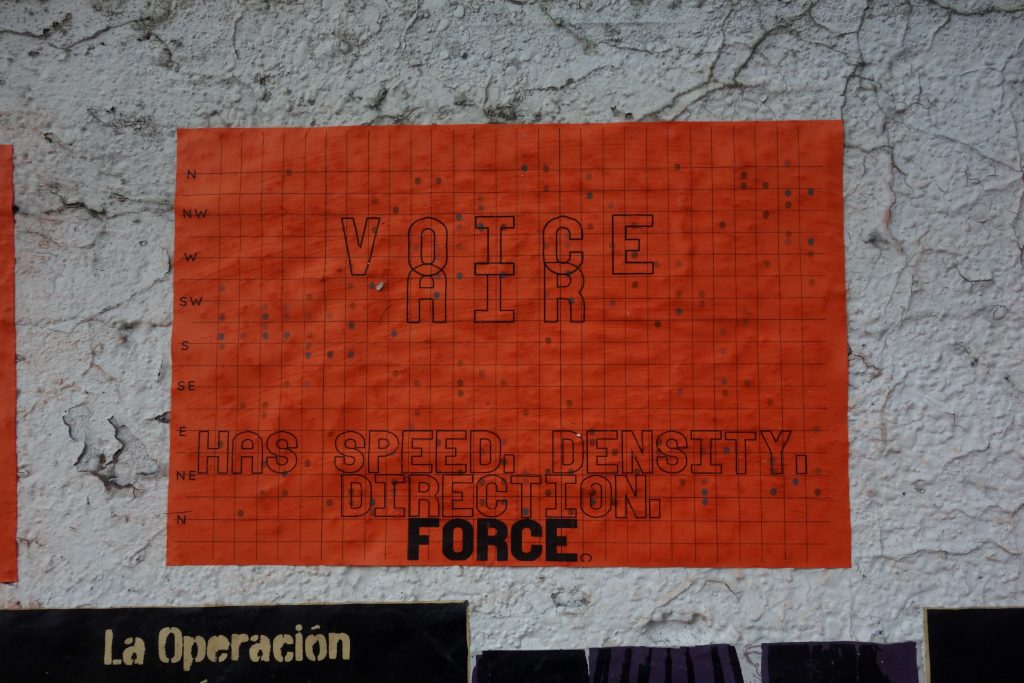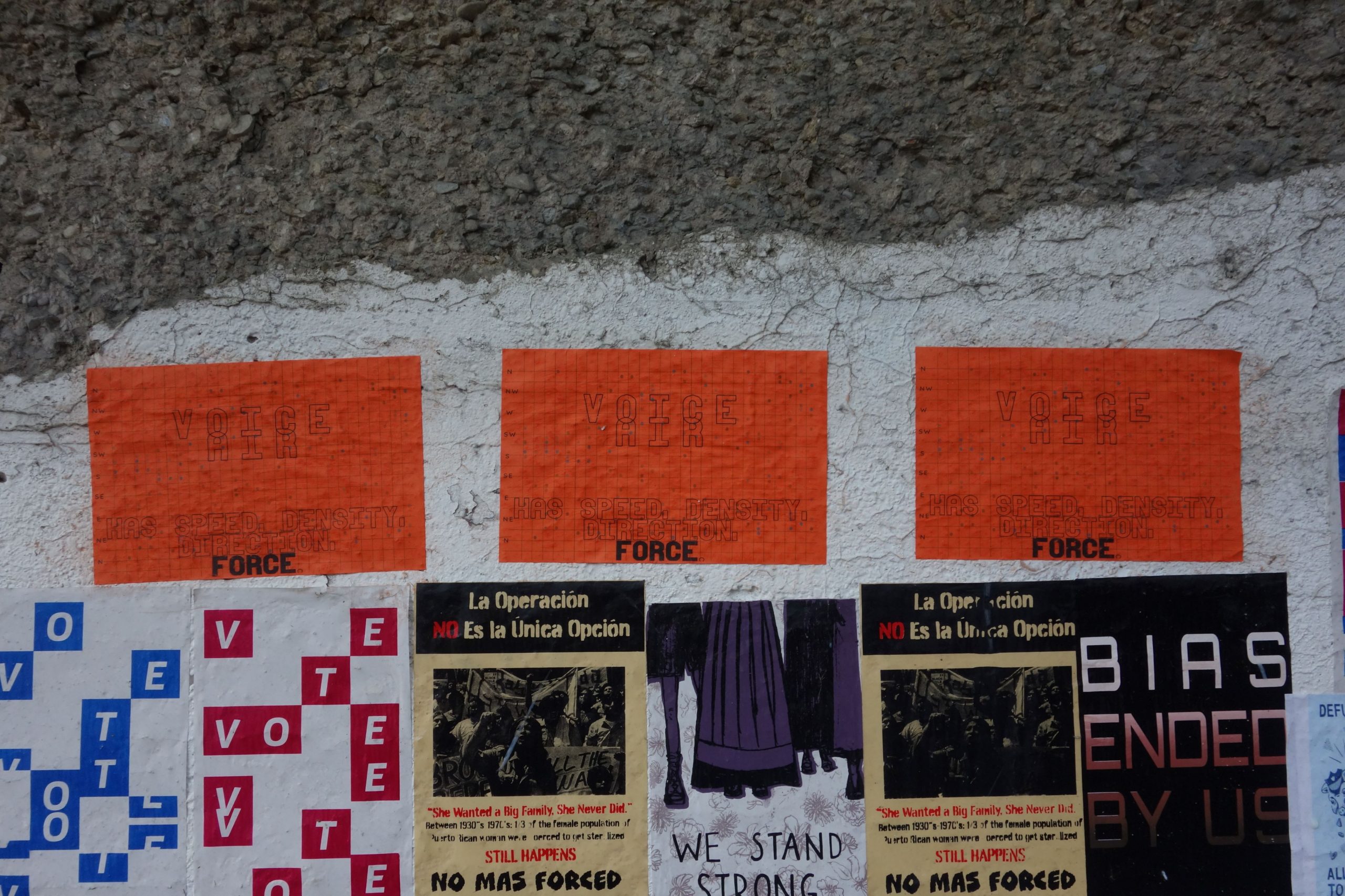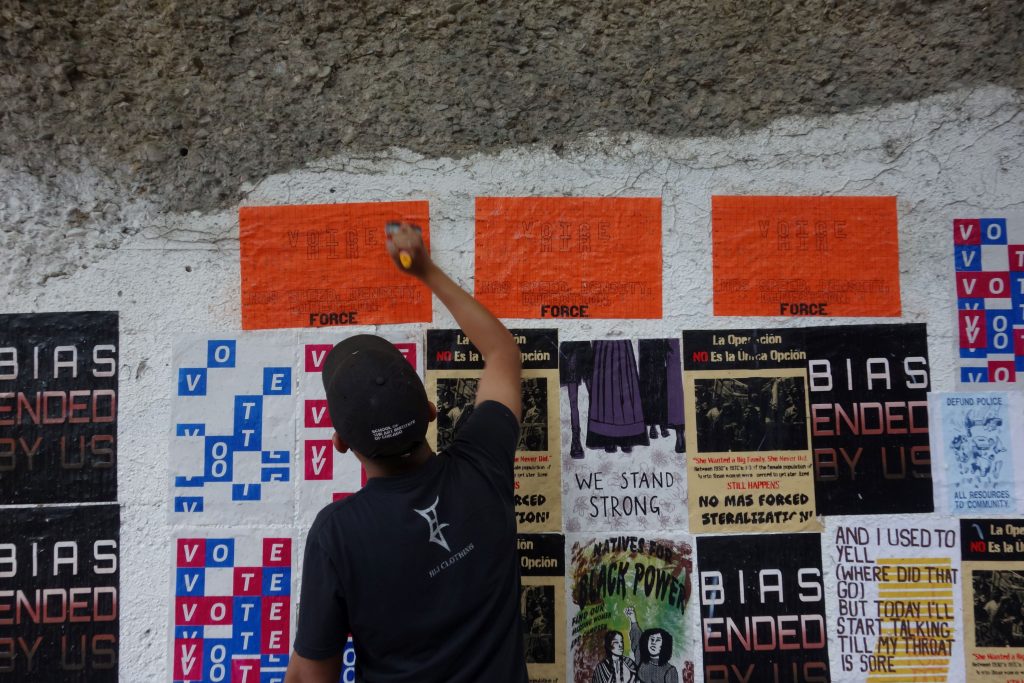An Introduction to
Earthquake Lights
By Yixiao Yao
I pretended to have never seen it
But in reality
We all had a hard time letting go of control over our senses
Being so aware of the touch
We lost the sensuality
Of being into the touch
Two months ago I read about this
Bakery of red
Asides the mountain
They heat up their bread from a volcano
What happens if you stare right into it
Can you see the lava; the magma; the ashes; the collision; the friction; the tectonic plates pulling apart?
Can you taste the earth; the quake; the pressure that has been built up deep down from the core?
Probably you wouldn’t
They aren’t gonna show you that
So much got hidden from us
So much you cannot see
The explosion; the trembling; the heat; the air and whatever was in the air were part of the aftermath
They are indirect
They are the effects
They are what we hear and feel and inhale
They are us
earthquake lights* (fragments of air)
collective reading and letterpress prints
By Laura Escobar
Earthquake lights are a seismic phenomenon in the atmosphere. When the earth shakes, air sags and light is refracted in a different way: air can be seen. Earthquake Lights can be experienced as a ceremony, it is a happening and a game: people gathering in the same space speak and listen to each other in a mutant reading and conversation scenario in which texts are embodied. Text becomes voice, air, and is seen folding like a seismic phenomenon in the atmosphere while we talk.
This selection of texts is a script for a possible collective reading; an array of fragments of the complete original piece. Focusing on air, voice, co-inspiration, breathing and moving masses of air and people on the earth, these fragments of air present a possibility to gather around and, together, trigger an earthquake.

֎ (this role will be held by whoever is leading the lecture and providing participants with a platform to read. Participants also read, talk, and announce the following text with a preceding number or word): improvises around -or reads-:
Welcome. We are all sitting here, sitting there, and we’re preparing ourselves to listen to each other while we’re reading at each other.
We will be using our voices and reading these texts out loud. This whole… ceremony is called Earthquake Lights and was initially part of a larger project called Earthquake Notice -or warning-, developed in Bogotá, Colombia, during the second half of 2020 in which Laura Escobar was researching and playing with the first laic publication printed in Colombia (or New Granada, back then in 1785): A chronicle that described, with suspicious detail, an earthquake that destroyed Bogotá on July 12th, 1785.
Anyway, these are all very different, very diverse, very suggestive pieces, clues or fragments of texts that I have received, written or found during Earthquake Notice’s research stage. These texts have become sound before, as it is about to happen again, as they are about to be given to you today.
An earthquake light is a luminous aerial phenomenon that appears in the sky at or near areas of tectonic stress, seismic activity, or volcanic eruptions. It is said that when tectonic plates move, or crash, producing an earthquake, these tectonic plates blend and so air masses over these pieces of land, sag and light is refracted in a different way than it regularly does. Air can be seen, hit by light when the Earth shakes. So, let’s begin: Number one: tremors.

1. Tremors
Shortly before, he said: “the main cause of the Earth’s tremors is the wind, this element, mobile on its own and that changes one place for another.
2. lungs
Whichever species first inflated their lungs with this air… it is the same air that we carry between our ribs. It stayed in our lungs until it was able to come out, perfectly regulated by thousands of years in which our vocal cords were slowly molded, and then it became a crude and impulsive whistle. It was stored, for millions of years, until four molars were removed from our jaws, giving space for a tiny portion of brain matter to grow, the tiny piece of meat that stores our ability to modulate. It remained in our lungs until it could be expelled decisively, stopped and beaten by three small muscles in our cheeks and lips that gradually became stronger. It was reserved, until a powerful membrane in the pit of our stomach became thin enough to acquire the power of movement and could modulate air. It was stored, for 720 million years inside us, until the tongue made our mouth a perfect resonance box.
The horizontal curve of that spiral movement is what we call voice. We can feel it more clearly when we whisper, when we are closer to silence.
Voice is air.
This voice, now, is the sound of the world’s first air.
֎ It has been said and shown that: We are Earthquake lights. Right now, our voices can be seen. I see your voice.
3. Empty space
Then he continued: “Wind, as long as it does not start moving and is present in an empty space, remains without offense or annoyance towards what is around it. But if an external cause stirs it up and drives it into a narrow place, then it will be happy to give up its place and will wander if it is allowed. But if the possibility of getting out is taken away from it and finds resistance, then, indomitable, it rolls and bellows in its confinement and makes the mountain moo deeply; having beaten these prisons for a long time, it uproots them and knocks them down with a violence as great as the obstacle.
4. Enclosed air
This violent passion and unfortunate morbidity is produced by air, enclosed and oppressed in the caverns, wombs and entrails of the subterranean world. Air is swollen, full of various spirits; replete with an abundance of flammable and combustible materials, it is rarefied and ignited (either by the fire of the pyrophyllae, or by rubbing these said materials together against each other). When the cave feels more narrow, confined air struggles to extend and dilate. It then charges with prodigious force at the walls of the cae, beats itself with them and shakes, until it breaks the weakest part and comes out wreaking havoc from the inner and superficial parts of the earth. If the materials enclosed and lit are of calmer spirits, and the cave is less narrow, these earthquakes remain as feints, that is, in a tremor, a swing, or a beat which lasts little, although it may be repeated many times; but if the included particles are of resinous, retouched and malignant materials such as nitre, alum, salt, ammonia, bitumen, carbon and others that contain much air, many exhalations and readiness to ignite, then they break the earth into one and many parts, they raise buildings and mountains and then drown and bury cities and provinces and all that is held on the shoulders of the surface.”
֎ Have we always understood the world, the Earth, the Universe as aligning with our own bodies? Does a mountain scream? Or are we able to scream only because a mountain does? If only we had learned our language from the Earth. Or, better said: if only we could remember our voice is the same voice that shakes inside the Earth’s womb.
5. masses of air | masses of people
Masses, as long as they do not start moving and are present in empty space, remain without offense or annoyance towards what is around them. But if an external cause stirs them up and drives them into a trap, then they will be willing to give up their place and will wander about. But if the possibility of getting out is taken away from them and they find resistance, then, indomitable, they rolls and bellow in their confinement and make the mountain moo deeply. Having beaten these prisons for a long time, they uproot them and knock them down with a violence as great as their struggle.
֎: May we say something about tremors. And something else about voice. In his lecture “Comment ne pas trembler” (“How Not To Tremble”), Derrida refers to the metaphor of the moving ground and the breathing air. He says: “The earthquake, the seismic shock and their aftershocks can become metaphors to designate any disturbing mutation (social, psychic, political, geopolitical, poetical, poetic, artistic) that forces a brutal change of terrain, that is to say, unpredictably, unpredictably. If I myself have often used and abused the figure or this seismic lexicon, what I see in this, and I will try to explain myself, is something more or something different than an easy way out or a rhetorical approach. We cannot help but tremble at the moment of thinking, of writing and, above all, of taking the floor, in particular when, for a lack of strength and time, we do it in a more or less improvised way; and especially, when it comes to questioning ourselves, as I was often tempted to do in the past, explicitly, literally, and systematically, about the meaning, the meanings, the different meanings, sometimes heterogeneous, as well as about the essence of trembling, about what it means to tremble.”
6. flowing inward
In his meteorologicorum, 11th book, chapter 8, he affirms that the cause of earthquakes isn’t fire, or water, or earth, but air with its vapors and exhalations, especially in cavernous lands. He says: “we must consider which body has more force to move, and it will mostly be the one that is more apt to advance greater distances and with greater impetus. The one which moves more quickly will necessarily have more impetus, since its speed strikes with more violence and can advance to greater distance and can go through everything; it will be the one that is more subtle: if the steam is so by nature, it will be, of all bodies, the one that has more strength to move because the fire, when united to the air, forms the flame and is released faster; therefore, nor water, nor earth are causes of earthquakes, but rather the steam, that when exhaled, flows inward.

7. First statement
Is not a flag, it is a statement .
YO SERÉ UN VOLCÁN
I WILL BE A VOLCANO
8. urgent
77 is the total number of massacres committed in Colombia during 2019, the year in which the biggest and longest anti-government strike blew up in the country since the 1950’s.
We walk on breathing soil and every single step we take goes directly into the Earth’s heart. Yes, our land is alive, but it is also urgent to wonder how many bodies we’ve stepped on. And, when we have walked upon them, where have our steps gone to?
9. Instructions
Instructions for revolution are also the instructions to trigger an earthquake:
Join a mob.
Bend the knees to propel the weight of the body upward.
Take your feet off the ground.
Surrender to gravity.
Fall.
10. active pessimism on neutrality
On neutrality
In October 2019, as part of a Visionary Fiction workshop in Bogotá, I first read Towards a Gender Disobedient & Anti-Colonial Redistribution of Violence by Jota Mombaça; a fierce, sharp and joyful manifesto that redeems violence as a tool of resistance. Like the powerful verse of a radical hymn, she says: “The monopoly of violence is a fictional power based on the promise that it is possible to create a neutral position from which to mediate conflicts.”
- Neutrality is associated with a dis-presence of the unviolenced body in conflict.
- Pessimism is opposed to neutrality. It is the opening to the speculation of possible worlds. However, pessimism surrenders us to defeat without any effort but with a particularity: the deep knowledge of the context of our defeat.
- Active pessimism, with the knowledge of defeat, names the possibility of transforming the context we inhabit, so camouflaged in dystopia that imagining alternate realities seems a silly daily exercise and, therefore, an obvious one.1
- Active pessimism, then, mobilizes thought, allows it to fictionalize reality in order to conceive other realities and shakes the entire cortex of Cartesian knowledge, based on reason and memory, and destabilizes it.
11. suffocates us
An ominous atmosphere envelops the planet. Air, saturated with the toxic particle of the colonial-capitalist regime, suffocates us.
12. interactions and transformations
“An autopoietic machine is a machine organized (defined as a unity) as a network of processes of production (transformation and destruction) of components which:
- through their interactions and transformations continuously regenerate and realize the network of processes (relations) that produced them; and
- constitute it (the machine) as a concrete unity in space in which they (the components) exist by specifying the topological domain of its realization as such a network.”
Maturana’s term, autopoiesis, has been delivered to a non-essentially scientific field, specifically to us. Now, in the context of this gathering of readings, we could jump to the conclusion that we all speak with the same air. This is, necessarily, co-inspiring. Living for, thanks to and with each other. And as beautiful as it may sound, it is also terrifying.
13. parallel activation
On presence
(…)
This is a question about physical reactions, about our bodies over time, and so is the term we’ve coined to name a sword of momentary victory, and to keep insisting: counter-hope.
- Counter-hope lies in the middle between reflection, imagination, and action.
- Counter-hope is a state of the body on which thought depends: the body acts while a thought is being formed.
- Thought and body remain in a parallel activation that corresponds to the present tense.
- Counter-hope is nothing other than active waiting, as opposed to the body waiting for Godot, silent, still and investing all its energy in the painful act of waiting without knowing.
- As a term, it necessarily refers to movement.
- Counter-hope requires thought to be incarnated, requires us to permanently embody. It requires ideas and abstract knowledge to be manifested in our bodies.
6.5. Or it requires that they step aside and yield the creative power to the body, as the beginning of the manifestations of an ancient way of knowledge, of approaching the world and the tools we have around us to be part of it.
- Counter-hope is the imminent appropriation of the disaster that is none other than the prodigious experience of the present (de Certau, 1996).
14. fortune
Who said that steady land (land ahoy!) is fortune?
15. Earthquake
Fourth and final statement:
We.
Are
The Earthquake.
16. Unfamiliar to us
Community doesn’t mean understanding everything about everybody and resolving all the differences; it means knowing how to work within differences as they change and evolve. Critical consciousness is a process of recognizing both limitations and possibilities. We need to collaborate with small and large social, political, specialized groups of people already informed on and immersed in the issues. And we need to teach them to welcome artists, to understand how art can concretize and envision their goals. At the same time, we need to collaborate with those whose backgrounds and maybe foregrounds are unfamiliar to us, rejecting the insidious notions of “diversity” that simply neutralize difference.
֎: My friend Nathali once wrote a note for her upcoming book in which she asked about a Lucy Lippard text, where are we now. Are you in your city, wondering, walking around? While we are sitting, reading this, are we saying something? Are we meaning? Who are we with? I wonder, mostly, if those paraphrased questions could translate into what I think is the main way of a creative, collaborative path to walk together: How are we speaking along? How are we breathing together? And, with whom? In some other of her notes, if I may quote her again without much context, she presents the image of us breathing along together with our enemies, as they are not able to breathe.
17.
We address the unwitting protesters. We seek allies. We need allies. We are under the impression that our allies are already out there, that they are ahead of us now, that there are many people who’ve had enough, who think, feel and work in a direction analogous to ours: this is not a fad, but something deeper, a kind of deeper time and in which convergent researches are being carried out in very different domains.
18.
(…) signs of what is to come: the emergence of all kinds of forces, from the most active to the most reactive, that will convulse the world and ourselves.
֎: Earthquake. Is us. And its lights, Our voices along with each other.
Notes
- Mombaça writes something important about this, which I allow myself to mention with the hope of forging it later: “The unsuspected power of fictions is that of being the foundation of the world”.
Laura Escobar lives and works in Bogotá, Colombia. Within her art practice, she writes, researches, teaches, and cooks. Her work takes place between visual arts, writing and intuitions about presence, voice, food, and gathering. Guided by an ongoing long-term experimental research about time and the way we perceive it and condition ourselves to that perception from physical to socio-political scenarios noted in natural phenomena. The way we relate to reality, language and other living forms is at the core of her research. Currently, Laura is a professor at multiple Arts and Creative Writing college programs in Bogotá, she is co-founder of todoestamal, an art and food collective based in the same city collaborating with independent publishing houses in Colombia.
